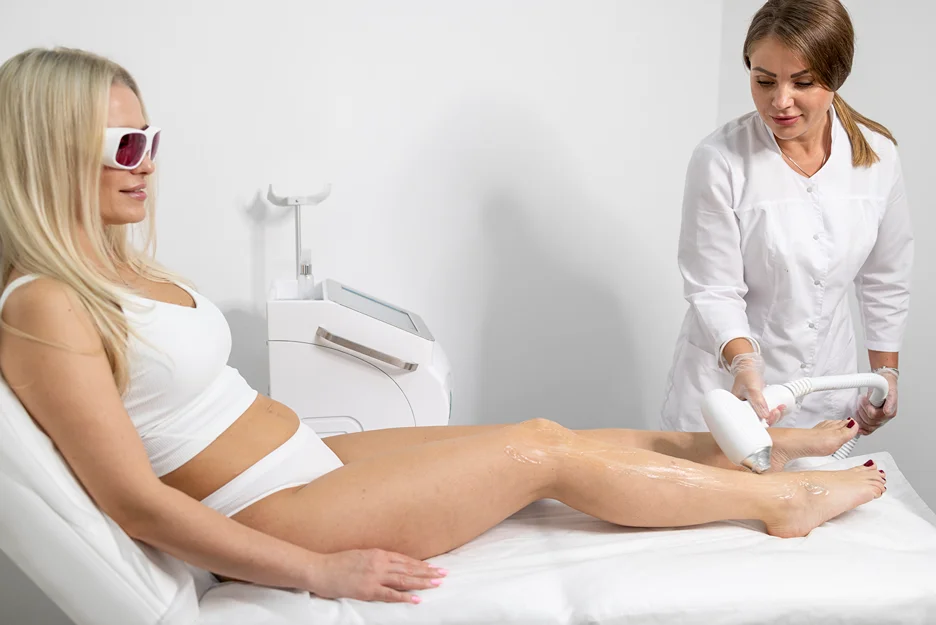Laser hair removal is one of the most popular aesthetic procedures, providing longer lasting hair reduction through photothermolysis. But many blonde and fair haired patients wonder – can laser removal work on my lighter hair?
Traditionally, lasers were limited in treating blonde and light colored hair. However, recent technological advancements have enabled laser devices to now work on blonde and fair hair.
In this complete guide, Dr. Soni from Ethos Spa will answer the top questions surrounding laser hair removal for blonde hair and help you understand how it works:
Why Hasn’t Laser Hair Removal Worked Well on Blonde Hair Historically?
Laser hair removal relies on targeting melanin in the hair follicle to damage the follicle and prevent future hair growth. So why don’t lasers work as well on blonde hair?
Dr. Soni will share his insights on some of the most popular questions:
Does Blonde Hair Have Melanin Pigmentation?
Melanin is the pigment that gives hair its color. Blonde hair has very low levels of melanin, which is why it appears light colored.
With less melanin pigment to target, lasers have difficulty identifying and heating blonde hair effectively.
| Type of Melanin | Characteristics |
| Eumelanin | Responsible for dark colors in skin, eyes, and hair. |
| Variations include black and brown eumelanin. | |
| Blonde hair results when there’s little brown eumelanin. | |
| Pheomelanin | Pigments lips, nipples, and other pinkish body parts. |
| People with equal eumelanin and pheomelanin have red hair. | |
| Neuromelanin | Responsible for the color of neurons in the brain. |
Do Lasers Rely on Pigment Contrast Between Hair and Skin?
Blonde hair does not provide enough pigment contrast with fair skin, making selectivity difficult.
Are Short Pulse Lasers Ineffective for Blonde Hair?
Early laser hair removal devices emitted short pulses and wavelengths of light. Short pulses often lack the depth to penetrate down the hair follicle, making it harder to damage blonde hair bulbs. The lack of melanin also meant short pulses would risk burning the fair skin.
| Type of Pulsed Light Source | Mechanism for Pulsing | Characteristics |
| Q-switched | Varies mechanisms | Varying pulse repetition rates, energies, and durations. Not commonly used for LLLT. |
| Gain-switched | Varies mechanisms | Varying pulse repetition rates, energies, and durations. Not commonly used for LLLT. |
| Mode-locked | Varies mechanisms | Varying pulse repetition rates, energies, and durations. Not commonly used for LLLT. |
| Superpulsed | Excited to higher levels by short pulses (µsecond) | Mainly used for LLLT. Reduces collateral thermal damage to normal tissue. |
| Chopped or gated | Pulsed power supply generated by a laser driver containing a pulse generator | Used in LLLT. Can also pulse LEDs or LED arrays. |
So in summary, blonde hair’s lack of pigment combined with limitations of early laser technology made removal traditionally ineffective or risky. But new developments are changing this.
How Do Modern Lasers Enable Blonde Hair Removal?

According to Dr. Soni, with hundreds of successful laser treatments under his belt, recent years have seen advanced laser hair removal techniques emerge to better treat blonde and fair hair.
| Trend | Description |
| Advanced IPL Technology | IPL devices are becoming more advanced, offering precise wavelength control and customizable settings. |
| Targeted Skin Concerns | IPL is used for a range of skin concerns, including hair removal, pigmentation, acne, and vascular issues. |
| Combination Therapies | Combining IPL with other treatments like radiofrequency or laser is gaining popularity for enhanced results. |
| At-Home IPL Devices | IPL devices for home use are becoming available, offering convenience for certain skin treatments. |
| Minimal Downtime | IPL treatments with minimal downtime are in demand, allowing patients to resume daily activities quickly. |
Can Lasers Artificially Dye Blonde Hair for Added Pigment?
Some newer devices use a specialized dye applied to hair follicles prior to treatment. The dye acts as an artificial chromophore to better absorb the laser energy, improving blonde hair removal. However, results are mixed.
Do Longer Laser Pulses and Wavelengths Help?
Many modern laser machines use longer pulses, which penetrate deeper and avoid relying as heavily on pigment contrast. Longer wavelengths also enable better cooling of the skin between pulses, improving safety.
Long Pulse Lasers
Over the last few years, laser technologists have found that lasers that shoot longer pulses create a safe environment for patients in general, making the procedure safer for individuals with blonde hair. Long pulses are safer for the following reasons:
Melanin Absorption: Longer wavelengths in laser hair removal reduce the risk of skin damage as they require less hair pigmentation to work effectively.
Deeper Reach: Longer wavelengths penetrate deeper into the skin, ensuring the laser reaches the follicle in the dermis while bypassing the epidermis.
Enhanced Safety: Longer pulses and wavelengths allow for more extended cooling periods between laser pulses, making the procedure safer for the patient.
Are Diode Lasers Better for Light Hair?
Laser diodes emitting 800-810 nm wavelengths show particular promise in blonde hair removal. Diode lasers better penetrate down the full follicle while minimizing melanin absorption in the skin.
Fluence of Two Types of Laser
| Laser Type | Wavelength (nm) | Skin Depth (mm) | Transmission (%) |
| Diode Laser | 810 | 1.32 | 14.5 |
| Alexandrite Laser | 755 | 1.32 | 11 |
Can Blonde Hair Be Removed with Multiple Laser Sessions?
Today’s safer lasers allow blonde hair to be treated through multiple successive sessions. More treatments are needed compared to dark hair, but cumulative damage to the follicles is possible over time.
So advanced technologies like long-pulse diode lasers now provide options for targeting blonde and light colored hair. However, proper technique and multiple treatments are needed for best results.
What Results Should I Expect with Laser Hair Removal on Blonde Hair?
While laser hair removal for blonde hair has improved, Dr. Soni emphasizes the importance of understanding the limitations and likely outcomes:
Is Permanent Hair Removal Possible on Blonde Hair?
Blonde hair removal is rarely permanent after a single treatment. However, when using a high quality laser and completing multiple sessions, longer term hair reduction is possible.
Will I Need More Treatments Than Someone with Dark Hair?
Yes, lighter hair needs more repeat treatments than coarse, dark hair. 8-12 sessions may be needed to see a significant reduction in blonde hair growth. Have realistic expectations for the number of visits required.
What Percentage of Hair Reduction Can I Expect?
With proper technique, blonde patients can achieve 30-80% long term hair reduction after a full course of treatments. However, darker hair can see 80-90% reduction with fewer sessions. Manage expectations accordingly.
How Long Will It Take to See Results?
Most patients see some shedding of treated blonde hairs 1-2 weeks after the first session. However, full results take 3-6 months following the final session. Time between treatments is needed to damage successive hair growth cycles.
Am I a Good Candidate for Laser Hair Removal on My Blonde Hair?
Dr. Soni says the best candidates have thick, coarse blonde hair growth contrasting fair skin. Fine vellus hairs are harder to damage. Avoid tanning which reduces skin contrast. Realistically assess your expectations based on ethnicity, hormones, area treated and other factors.
What Are the Risks Associated with Laser Hair Removal on Blonde Hair?
While minimized with expert technique, potential side effects include:
- Burns, blisters or scarring if the laser overheats the skin
- Skin discoloration or hyperpigmentation from melanin overproduction
- Eye injury if eye protection isn’t worn
Choose an experienced laser technician specially trained in treating lighter hair. Avoid direct sun exposure for 1-2 weeks pre and post treatment.
Does Electrolysis Work Better Than Laser for Permanent Blonde Hair Removal?
Electrolysis is an FDA approved hair removal method using an electrical current applied directly into the follicle. This destroys hairs regardless of pigment. However, Dr. Soni would like to remind us that electrolysis has downsides:
- More painful than laser treatments
- Very time consuming, requiring numerous sessions
- Less effective on hormonal hair growth
For blond hair removal, laser techniques may still provide better long term reduction when performed properly over multiple visits. Consult with Dr. Hardik Soni of Ethos Spa to compare your options.
How to Find the Best Laser Hair Removal for Blonde Hair in New Jersey

If you’re seeking safe, effective laser hair removal tailored to blonde hair, turn to Dr. Hardik Soni and the expert staff of Ethos Spa. Serving the Summit, NJ area, Ethos Spa provides advanced laser treatments using proven long-pulse diode technology.
Ethos Spa gets lasting results on even the lightest hair colors. Book a consultation with Dr. Soni to determine your options. Contact Ethos Spa today to start your journey towards silky, stubble-free skin.
Learn more: Does Soprano Ice Laser Work on Blonde Hair?







